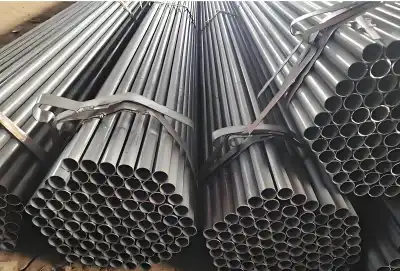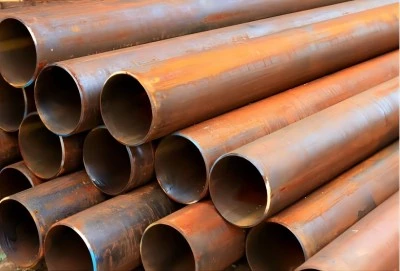In the world of steel pipe manufacturing, API 5L ERW (Electric Resistance Welded) pipes and LSAW (Longitudinal Submerged Arc Welded) pipes represent two distinct manufacturing approaches, each with unique characteristics and applications. These pipes, manufactured according to API (American Petroleum Institute) specifications, serve crucial roles in oil and gas transportation, construction, and various industrial applications. Understanding the key differences between these pipe types helps engineers, contractors, and project managers make informed decisions for their specific requirements.
|
|
|
Manufacturing Process
The manufacturing process for ERW and LSAW pipes differs significantly, impacting their final properties and applications. ERW pipe production begins with steel coil or strip, which undergoes continuous roll forming into a tubular shape. The edges are heated through electrical resistance and pressed together to create a high-frequency welded seam. This process occurs at relatively lower temperatures compared to LSAW welding, typically around 1,200°C to 1,300°C.
LSAW pipe manufacturing involves a more complex process. Steel plates are initially formed into a cylindrical shape using powerful plate-bending machines. The longitudinal edges are prepared with bevels, and the pipe undergoes submerged arc welding from both inside and outside. This process typically operates at temperatures reaching 1,500°C to 1,600°C. The dual-sided welding ensures complete penetration and fusion of the steel, creating a robust joint capable of withstanding high pressures.
ERW pipes generally range from 2-3/8 inches to 24 inches in diameter, while LSAW pipes can be manufactured in larger diameters, typically from 16 inches to 100 inches. The thickness capabilities also differ, with ERW pipes usually limited to 0.5 inches, while LSAW pipes can accommodate thicknesses up to 2 inches or more.
Surface Quality
ERW pipes demonstrate superior surface quality characteristics, attributable to their manufacturing process. The continuous roll forming and high-frequency welding create a consistently smooth surface finish. The weld seam appears as a thin, uniform line along the pipe's length, barely distinguishable from the base material. The surface treatment options for ERW pipes include various coating systems, from basic paint to advanced multi-layer coatings, which adhere exceptionally well to the smooth surface.
Surface quality in ERW pipes benefits from automated process control systems that maintain precise welding parameters throughout production. This consistency results in minimal surface irregularities and excellent roundness tolerance. The absence of reinforcement welds on either side of the pipe contributes to the smooth profile, making ERW pipes particularly suitable for applications requiring minimal flow resistance or frequent pigging operations.
LSAW pipes, while robust and reliable, present a different surface profile. The submerged arc welding process creates visible weld reinforcement on both the inner and outer surfaces. These weld beads, though properly controlled, result in a less smooth surface compared to ERW pipes. The surface preparation requirements for LSAW pipes often include additional grinding or machining of the weld reinforcement areas to achieve specific smoothness requirements.
Defects And Detection
ERW pipe manufacturing incorporates advanced quality control measures that facilitate early detection of potential defects. The primary inspection zone focuses on the weld seam, where most defects typically occur. Common defect types include hook cracks, lack of fusion, and cold welds. However, these defects are relatively easy to detect using modern inspection technologies.
Ultrasonic testing proves particularly effective for ERW pipe inspection due to the consistent wall thickness and straightforward weld geometry. The inspection process can detect defects as small as 0.004 inches, ensuring high reliability. Online monitoring systems during production can immediately identify welding issues, allowing for quick adjustments to prevent defect formation.
LSAW pipes face more complex inspection challenges due to their manufacturing process. The dual-sided welding creates opportunities for various defect types, including incomplete penetration, slag inclusions, and porosity. The thicker walls and larger weld volumes require more sophisticated inspection techniques. Radiographic testing often complements ultrasonic inspection to ensure comprehensive defect detection.
The inspection of LSAW pipes must account for potential defects in both the inner and outer weld passes, as well as the heat-affected zones. The presence of weld reinforcement can complicate ultrasonic testing, requiring specialized techniques and equipment calibration. Automated ultrasonic testing systems typically employ multiple probe arrays to achieve complete coverage of the weld area.
Residual Stress
Residual stress patterns differ significantly between ERW and LSAW pipes due to their distinct manufacturing processes. ERW pipes generally exhibit lower residual stress levels, attributable to several factors in their production sequence. The high-frequency welding process concentrates heat in a narrow zone, limiting the extent of thermal expansion and contraction. Following welding, ERW pipes undergo sizing operations that help redistribute and minimize residual stresses.
The sizing process in ERW pipe production involves mechanical working of the pipe through sizing rolls, which helps normalize stress distributions throughout the pipe body. This process, combined with proper cooling practices, results in more uniform and generally lower residual stress patterns compared to LSAW pipes. The reduced residual stress contributes to better dimensional stability and reduced susceptibility to stress-corrosion cracking.
LSAW pipes typically contain higher levels of residual stress due to the intensive heat input during the submerged arc welding process. The multiple weld passes and larger heat-affected zones create more complex stress patterns throughout the pipe wall. While stress-relieving heat treatments can mitigate these effects, the inherent nature of the LSAW process results in higher residual stress levels compared to ERW pipes.
API 5L ERW Pipe For Sale
LONGMA GROUP has established itself as a leading manufacturer and supplier of API 5L ERW pipes, offering a comprehensive range of products that meet both PSL1 and PSL2 specifications. Their manufacturing capabilities extend to LSAW steel pipes, providing customers with flexible options based on specific project requirements. The company maintains rigorous quality control processes aligned with international standards.
For those seeking reliable API 5L ERW pipe suppliers, LONGMA GROUP offers professional consultation and support through their dedicated sales team. Interested parties can initiate contact via email at info@longma-group.com to discuss specific requirements, technical specifications, and pricing options. The company's commitment to quality and customer service has established it as a trusted partner in the steel pipe industry.














